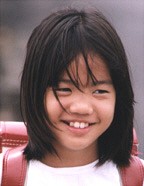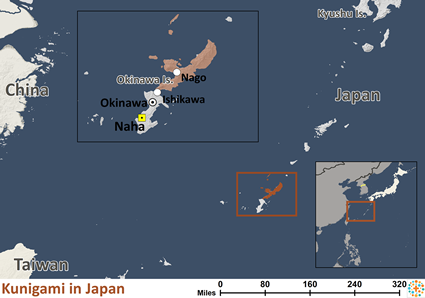The Kunigami of Japan are made up of seven closely related people groups living in the Ryukyu Islands. This small chain of islands, which includes Okinawa, is located to the southwest of Japan, between Kyushu (the southern tip of Japan) and northeastern Taiwan. The Ryukyuan peoples are of Japanese and southeast Asian descent. Their languages vary from island to island and their dialects from village to village.
Although their dialects are all quite similar to Japanese, the tribes are not able to understand one another. Some of the once dominant native languages spoken include Northern and Southern Amami-oshima, Toku-no-shima, Oki-no-erabu, Southern Ryukyuan, and Yayeyama. Unfortunately, all of these are gradually being replaced by Japanese among the younger Kunigami, who speak little or none of these own languages.
In times past, while under subjection to China and Japan, the Kunigami learned to be peaceful and accepting, while considered "backward" and "culturally less" by others.
Long ago, the Kunigami lived as independent merchants who sailed to China, Japan and other Asian seaports. Today, most are farmers. They raise sweet potatoes and rice, their staple foods, as well as other cash crops.
The family is the center of Kunigami cultural life. It is not unusual to see entire families leaving together to tend the fields, where each one is responsible for his share of work. The people work hard and long and have very little spare time. In general, a Kunigami does not like being alone. Any amount of free time they can afford is spent with their families or friends. The younger children often sleep together and older widows may have one of their grandchildren sleep with them.
Kunigami women are traditionally kept in subjection to their husbands. At celebrations, the men stay separated from the women, usually drinking sake (rice wine).
According to family tradition, a firstborn son has the greatest financial advantage. After marriage, the firstborn son and his wife live in his father's house until his parents have died. However, long before that time, he is responsible for managing the rest of the family and its finances. In times past, the fear of "dishonoring one's family" kept crime under control in the smaller communities.
Kunigami children enter school at eight or nine years of age and continue until they reach about sixteen. Today, there are three universities in the island region. Formerly, their goals included acquiring an abundance of livestock, food, and friends, and having as large a family as possible. Since the Japanese took control of the islands in 1879, these goals have changed. The Japanese introduced a system of education that discouraged students from speaking their native languages and encouraged them to speak Japanese. The students were even punished for speaking their own languages in class. Consequently, the native languages have been lost as the younger Kunigami have sought to identify with something they consider greater than themselves: a world class nation.
Progress through education and contact with the outside world has moved the Kunigami from a self-sufficient lifestyle to one of dependence on outside factors. These factors include selling cash crops, making money through tourism, and working for soldiers on U.S. military bases. Many Kunigami have moved to larger islands or other countries in search of jobs and better living conditions.
Most sources consider the Kunigami to be Buddhist; however, traditional shamanistic practices are still prevalent. This means that they believe in many unseen gods, demons, and ancestral spirits. The spirits of their ancestors are believed to live in the tombs where they were buried. The people believe that the spirits must be regularly invited back into the lives of their descendants so that they may continue to exist. For this reason, each person considers himself a continuation of the life of his family.
The people also believe that unseen powers known as kami control the ancestral spirits and other areas, including the sea and land. The ancestral spirits are honored on a community level, but the kami are worshipped privately in the homes. If the kami are not appeased, it is believed they can bring harm to a family or individual. The people must seek permission from the kami before making any type of decision.
The father of the house maintains the religious rituals in the home and cares for the ancestral tombs. The women serve as "mediators" between the kami and the people.
Because the Japanese consider the Kunigami second class citizens, the Ryukyu Islands have become "dumping ground" for the mainland's elderly and handicapped citizens. The Kunigami search for national pride and association with the rest of the world has not afforded them with the peace they desire. They need to know that true peace can only be found in Jesus Christ.
Pray that God will grant wisdom, favor and the anointing of the Holy Spirit to anyone reaching out to the Kunigami community.
Ask God to give the Kunigami believers opportunities to spread the gospel among their own people through discipleship.
Ask the Lord to raise up strong local churches that will plant more churches.
Pray for spiritual hunger among the Kunigami people, driving them to the cross.
Scripture Prayers for the Kunigami in Japan.
https://en.wikipedia.org/wiki/Kunigami,_Okinawa
| Profile Source: Joshua Project |

























